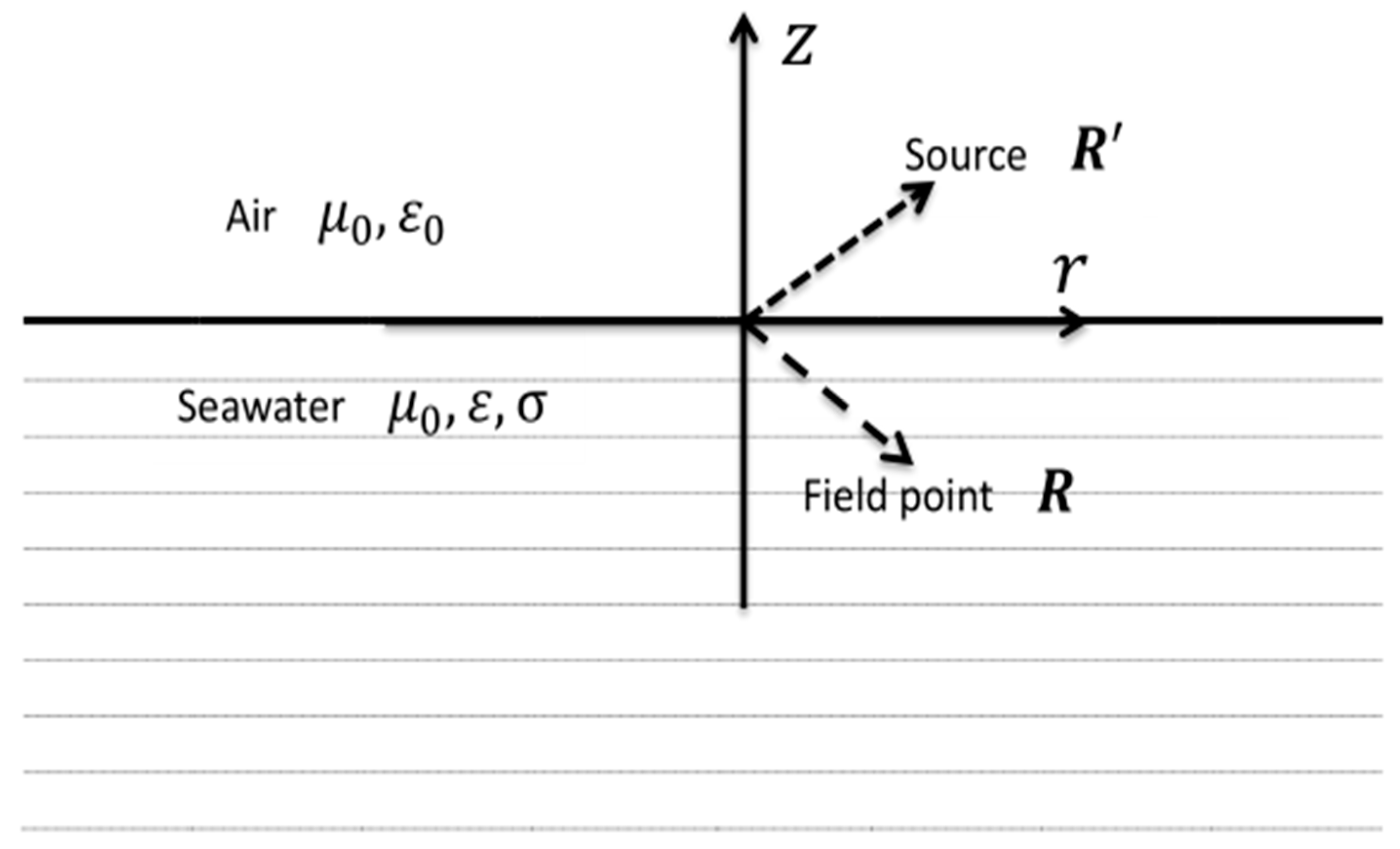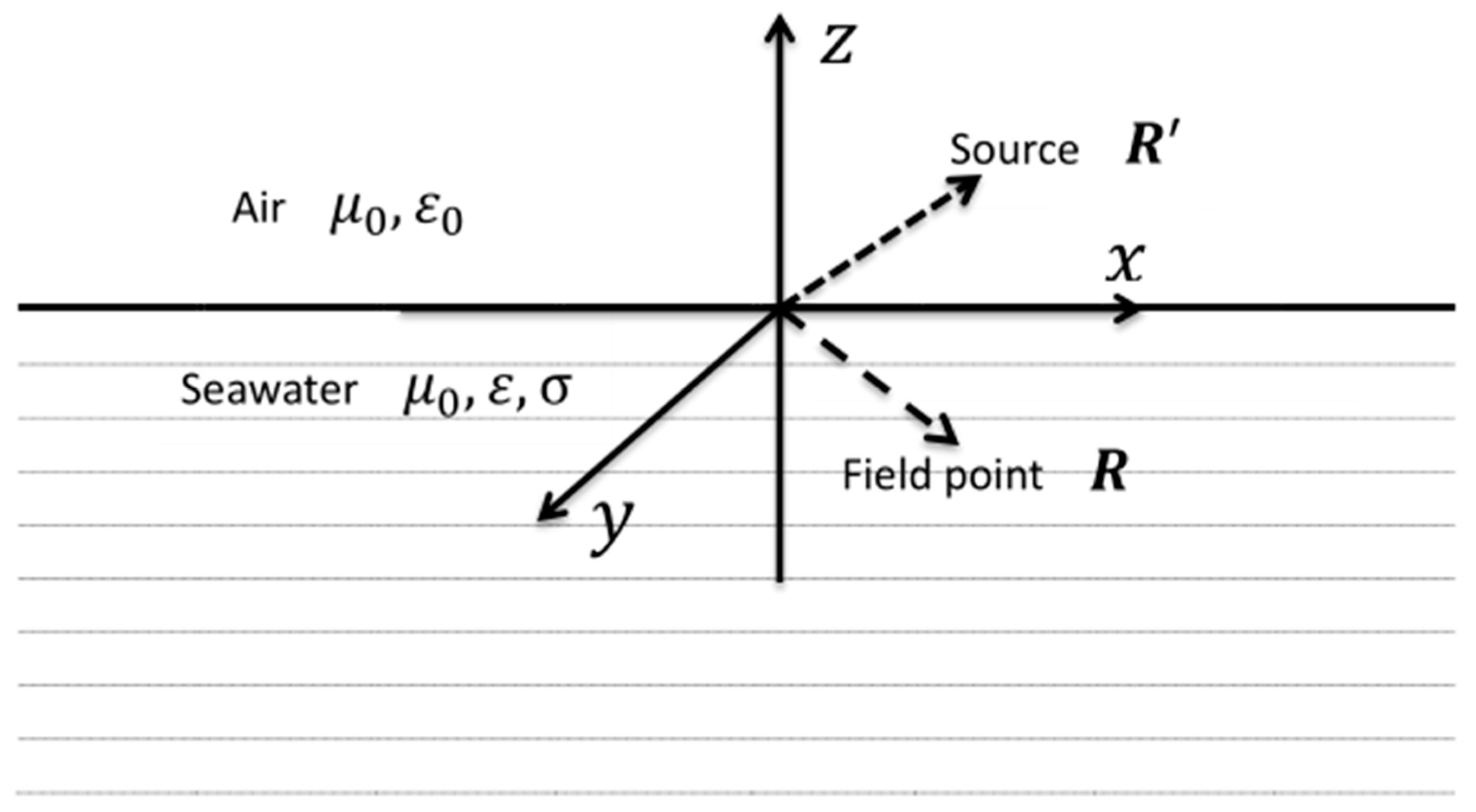In recent years, there has been tremendous interest in studying the electromagnetic field generated by a current source. According to the two-layer model of the cylindrical coordinate system, we propose an air-seawater two-layer model based on space rectangular coordinate system, which can be used to solve the electric field in air and seawater.
4.1. The Two-Layer Model in Cylindrical Coordinates
The sea surface divides the space into two parts as shown in
Figure 1, half of which is filled with air and the other half is seawater. Let
be the air-seawater interface.
denotes the upper half-space while
represents the lower half-space. The position of the source is represented by the
.
and
are the position vectors to field and source points, respectively.
The propagation constants in the two parts of the medium are
where
represents magnetic conductivity tensor.
are the permittivity and permeability, respectively.
Let
be a current source in the air. Time harmonic factor is
.
is the electric field in the air and
is the electric field in the seawater. We can obtain the wave equations as follows
with
and
being subject to the following boundary and radiation conditions
The corresponding electric DGF wave equations and boundary conditions are as follows
where
indicates that the field point and the source point are both in the seawater,
denotes that the field point is in the seawater and the source point is in the air. The relations between the electric DGF and the electric field are
It is, easy to show that once we know and , and can be obtained. To begin with, we should introduce the electric DGF, and then, we can get the electric field.
Theorem 3. Assume that and are the vector wave functions of , and are the vector wave functions of . and are continuous eigenvalues. The electric DGF in the cylindrical coordinate system can be written aswhere is defined as followswhere identifies the eigenvalue parameter. Proof. The cylindrical vector wave functions
and
can be defined by
where
.
represents the n-order Bessel function.
and
denote the odd and the even function, respectively. The functions
describe the electric field of
mode in a cylindrical waveguide and the functions
for the
mode. The cylindrical vector wave functions are defined in the range of
,
,
.
The trick of the proof is to find the magnetic DGF of free space
, which satisfies
where
is the source function and
represents the wave number.
For cylindrical vector wave functions involving continuous eigenvalues, we assume that the source function is given by
where
and
are two undetermined position vector coefficients.
and
are continuous eigenvalues. Due to the linear correlation between
and
, the integral range of
is
. After taking the dot product of (46) with
and integrating over volume
, we have
Using the orthogonality of the vector wave functions and the normalization coefficient formula, we get
Similarly, we can obtain
where
and
is defined as the Kronecker delta function respect to
Thus, we can get the eigenfunction expansion of the source function as follows
Substituting (53) into (48),
can be computed by
Because the pole of the integral is located in
, the
can be obtained from the residue theory
where
Due to the relation of electric DGF and magnetic DGF
we can get the electric DGF
in the cylindrical coordinate system
where
and
are the vector wave functions of
. The proof is completed. □
Next, we discuss the DGF of the two-layer model. It is observed from
Figure 1 that when the source is in the air, the electric field in the air comes from the superposition of the scattering field of the source point and the field point. The electric field in the seawater is equal to the scattering field in the seawater. From the above analysis, the DGF for two-layer model is therefore given by
What we discussed above is called the principle of scattering superposition, which is widely applied to solve multilayer medium model.
Suppose that
where
,
.
and
are vector wave functions in the air.
and
are the solutions of the wave equations in seawater.
are the unknown coefficients. To determine the unknown coefficients in the assumed DGFs, the boundary conditions (41) have to be satisfied at
. Combined with the principle of scattering superposition (58), we find
where
.
In summary, when the source is in air, the electric DGF of two-layer medium model can be expressed as
where
indicates the DGF of the upper level, and
represents the DGF of the lower level.
According to the DGF of two-layer model, the electric field in air and seawater can be calculated by
where
denotes the current source in the air.
Suppose that there is an infinitely small vertical electric dipole in the air whose coordinate is
.
indicates the current moment. The current density of an electric dipole in the air can be expressed as
where
By substituting
into the vector wave functions (41)~(44), vector wave functions are simplified to
As we can see, the vector wave functions are more concise in form than before. If we plug simplified vector wave functions back into (61) and (62), we have
Once we have the DGF, the electric field can be solved immediately. By applying (63) and (64), the electric field in the air and seawater can be expressed in the form of
The Bessel function in the above electric field expression is obviously not conducive to the solution of the electric field. It is worth noting that the Bessel function can be expressed by asymptotic expression when
is large enough; the vector wave functions, therefore, become
The approximate expressions for electric field, using (46) with the functions and replaced by above equations, can be solved efficiently and easily.
For the two-layer model in cylindrical coordinate system, the approximation of the electric field has been obtained by using the asymptotic expression of the far-zone field. Compared with the integral of Bessel function, the simplified electric field can handle the mathematical difficulties.
4.2. The Two-Layer Model in the Space Rectangular Coordinate System
We now turn to the two-layer model in space rectangular coordinate system. It is apparent from
Figure 2 that the sea level
divides the air and seawater into two parts.
Similarly, electric DGF also satisfies the wave equations and boundary conditions (41). Next, we need to introduce the following vector wave functions of rectangular coordinate system. The vector wave functions
and
are defined as
where
and
stand for the odd and the even functions, respectively.
and
stand for the eigenvalue parameters. It can be easily shown that the magnetic DGF
satisfies
The domain is
,
,
. When
and
, the boundary condition is
Since
and
satisfy the boundary condition defined by (79), we assume that the eigenfunction expression of the source function is
where
and
are two undetermined position vector coefficients. In order to solve these two coefficients, we need to take the dot product of (80) with
and integrate over volume
Applying the dyadic calculation formula
to the left-hand side of (81) yields
By the Dyadic Gauss theorem, we have
where
is used to indicate the gradient operator on the variable
. Since
is in
, the surface integral in (83) is equal to zero. Using the orthogonality of the vector wave functions and the normalization coefficient formula, we can rewrite the right-hand side of (81) as
In conclusion, (81) can be rewritten as
Thus,
is given by
Similarly, we obtain
where
Therefore, we can get the eigenfunction expression of the source function as follows
Inserting the expression (88) into (78) gives
Using the loop integral method, the Fourier integral in (89) can be obtained. Since
, the integral has two poles at
, and satisfies Jordan lemma at infinity. Furthermore, (89) can be derived as
where
where
and
are the vector wave functions of
.
is defined as.
Suppose that the source is in the air, using the scattering field superposition method, we have
where
is the DGF in the air,
represents the DGF in the seawater.
Assume that
and
are
where
,
.
and
are the solutions of the wave equations in the air,
and
are the solutions of the wave equations in seawater.
are the unknown coefficients. Combining with the boundary conditions (41), we can obtain the values of the unknown coefficients
where
.
In the space rectangular coordinate system, when the source is in air, the DGF of the two-layer medium model can be expressed as
It can be seen that the DGFs in the space rectangular coordinate system and the cylindrical coordinate system are very similar in form.
The electric field is calculated by DGFs. After solving the system, we can get the electric field in air and seawater
where
represents the current source in the air.
4.3. The Two-Layer Model in the Sphere Coordinate System
In this section, we will discuss the DGF in spherical coordinate system depicted in
Figure 3. Overall, the process of computing the DGF is the same as before. As shown in the
Figure 3, the sphere divides the space into two parts, internal and external. Let the outside of the sphere be the first layer and the inside be the second layer. The source is assumed to be in the first layer which is located in
. In this way, we can use DGF to solve the electric field inside and outside of the sphere. The two-layer model can be used in the study of superlenses.
Firstly, the vector wave functions in spherical coordinate system are given by [
26]
where
presents
-order spherical Bessel function,
and
indicate the eigenvalue parameters.
denotes the wavenumber.
is a Legendre function of the first type with order
and it has the following property
Similar to the derivation of DGF in cylindrical coordinate system, we can obtain free space DGF in spherical coordinate system
where
is the position vector of field point and
denotes the source point.
According to the principle of scattering superposition (96), the DGFs of scattering field can be derived as
where the unknown coefficients
can be determined by boundary conditions. For a perfect electromagnetic conductor, since the electric field in the sphere is zero, we can get
where
indicates the Bessel function and
is the Hankel function. The radius of the sphere is denoted by
.
Next, we analyze the expression of the electric field generated by the vertical electric dipole and solve the expression of the electric field by using the DGF in the spherical coordinate system. The derivation is similar to the calculating process in the cylindrical coordinate system and rectangular coordinate system. Therefore, the following part will only focus on the derivation which is obviously different from above.
Suppose the electric dipole is located on the
Z-axis and its spherical coordinate is
. The current source is expressed by
where
stands for the current moment.
The vector wave functions can be simplified
The simplified DGFs are given by
As far as the electric field concerned, it is of course necessary to use (101) and (102). Finally, we get
In this section, we give the universal form of wave functions in three common coordinates. Combined with the principle of scattering superposition, the DGFs for the two-layer model are proposed. Then the expressions for the electric field are obtained. By observing the electric field of the two-layer model in the three coordinate systems, it can be found that the electric field generated by the vertical electric dipole only contains the TM wave mode. Similar DGFs and electric field expressions are presented in [
27], which can confirm the reasonableness of our derivation.






